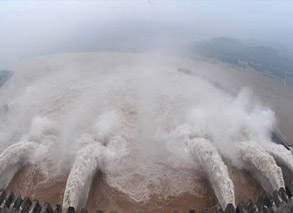Drepung monastery in Tibet starts renovation
2009-06-26 09:17 BJTSpecial Report: Tibet in 50 Years |
LHASA, June 25 (Xinhua) -- A renovation project of the Drepung Monastery, in southwest China's Tibet, started on Thursday as part of the country's efforts to better protect cultural heritage in the autonomous region.
 |
| Photo taken on June 25, 2009 shows the figure of Buddha at the Drepung monastery in Lhasa, southwest China's Tibet Autonomous Region. The ground-breaking ceremony of the water supply and drainage project of the monastery was held here on Thursday. The Chinese government invested 17.39 million yuan (RMB) on the project, which involves the construction and upgrade of water supply and drainage systems of the Drepung Monastery. Built in 1416 on the outskirts of Lhasa, the Drepung Monastery is the largest and most influential monastery of the Gelug Sect, a branch of the Tibetan Buddhism. (Xinhua/Purbu Zhaxi) |
The renovation began with the monastery's facilities for drinking water supply, drainage and firefighting, which will cost 17.39 million yuan (2.54 million U.S. dollars) from regional government, Lhasa city government and monastery funds.
"Due to a long history and natural erosion, the ancient buildings of the monastery have problems as wall cracks and damage from moths," said Yudawa, director of the Tibet Regional Cultural Heritage Bureau. "It is very necessary to conduct timely preservation."
The Drepung Monastery in the western outskirts of the regional capital Lhasa, dates from 1416. Its buildings cover 200,000 square meters.
The central government will invest 65 million yuan in the renovation.
The monastery remains open to visitors during the renovation. The completion date is unclear.
The monastery was closed to visitors after the March 14 riot last year, but it reopened last August.
China launched a 570 million yuan (83.4 million U.S. dollars) project to preserve 22 historical and cultural relics in the region in April last year. The project, the country's largest protectionist move in the region, will last until 2010. It includes 15 monasteries under state-level protection.

 Mail
Mail Share
Share Print
Print


 Video
Video









 2009 China Central Television. All Rights Reserved
2009 China Central Television. All Rights Reserved